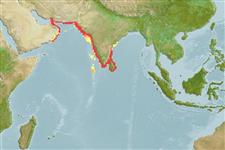分類 / Names
共通名の | 類義語 | Catalog of Fishes(部類, 種) | ITIS | CoL | WoRMS | Cloffa
Environment: milieu / climate zone / depth range / distribution range
生態学
海 底生の; 深さの範囲 2 - 300 m (Ref. 28016), usually 10 - 120 m (Ref. 11441). Tropical; 29°N - 5°N, 56°E - 83°E (Ref. 5222)
Indian Ocean: continental shelf of the northern Indian Ocean from the Gulf of Aden to Sri Lanka and Madras, India. Not known from the Persian Gulf nor the Red Sea. Records from the western Pacific are based on misidentifications of Epinephelus stictus or Epinephelus fasciatomaculos.
Length at first maturity / サイズ / 重さ / 年齢
Maturity: Lm 39.2 range ? - ? cm
Max length : 55.0 cm TL オス/雌雄の選別がない; (Ref. 3)
背面の脊椎 (合計) : 11; 背鰭 (合計) : 15 - 17; 肛門の骨: 3; 臀鰭: 8.
Occurs over muddy sand or mud substrata and caught in depths of 63 to 100 m off the Kerala coast. Minimum depth reported taken from Ref. 9773.
Life cycle and mating behavior
成熟 | 繁殖 | 放精 | 卵 | 生産力 | 幼生
Heemstra, P.C. and J.E. Randall, 1993. FAO Species Catalogue. Vol. 16. Groupers of the world (family Serranidae, subfamily Epinephelinae). An annotated and illustrated catalogue of the grouper, rockcod, hind, coral grouper and lyretail species known to date. Rome: FAO. FAO Fish. Synop. 125(16):382 p. (Ref. 5222)
IUCNのレッドリストの状況は (Ref. 130435: Version 2024-1)
Human uses
水産業: 商業
用具
特記事項
XMLをダウンロードして下さい
インターネットの情報源
Estimates based on models
Preferred temperature (Ref.
123201): 22.5 - 28.6, mean 27 °C (based on 280 cells).
Phylogenetic diversity index (Ref.
82804): PD
50 = 0.5000 [Uniqueness, from 0.5 = low to 2.0 = high].
Bayesian length-weight: a=0.01096 (0.00941 - 0.01277), b=3.03 (3.00 - 3.06), in cm total length, based on LWR estimates for this species (Ref.
93245).
栄養段階 (Ref.
69278): 4.0 ±0.52 se; based on food items.
回復力 (Ref.
120179): 手段, 1.4年~4.4年の倍増期間の最小個体群 (K=0.21-0.86; Fec=4,165).
Fishing Vulnerability (Ref.
59153): Low to moderate vulnerability (27 of 100).
Nutrients (Ref.
124155): Calcium = 97.8 [43.3, 230.3] mg/100g; Iron = 1.08 [0.49, 2.64] mg/100g; Protein = 17.9 [16.3, 19.5] %; Omega3 = 0.243 [0.127, 0.461] g/100g; Selenium = 88.2 [41.0, 208.6] μg/100g; VitaminA = 29.5 [6.8, 121.5] μg/100g; Zinc = 1.14 [0.71, 1.89] mg/100g (wet weight);
